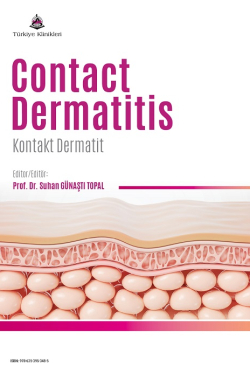Mechanisms in Irritant and Allergic Contact Dermatitis
Dilek DAŞGINa
aMuğla Sıtkı Koçman University Faculty of Medicine, Department of Dermatology, Muğla, Türkiye
Daşgın D. Mechanisms in irritant and allergic contact dermatitis. In: Günaştı Topal S, ed. Contact Dermatitis. 1st ed. Ankara: Türkiye Klinikleri; 2024. p.1-7.
ABSTRACT
Contact dermatitis can be in the form of irritant contact dermatitis (ICD), which occurs when the skin is exposed to irritants, or allergic contact dermatitis (ACD), which occurs when the skin is exposed to allergens. Today, there are many known allergens and especially irritants that individuals are exposed to occupationally. Although ICD and ACD reactions have similar clinical and histological features, they have differences in terms of pathogenesis. ICD occurs as a result of the activation of the innate immune system due to the direct cytotoxic effect of the irritant agent; prior sensitization is not required. ACD is a delayed hypersensitivity reaction in which allergen-specific T cells take part in the inflammatory process. In ACD, after sensitization with an allergen, dermatitis occurs with re-exposure to the same allergen. In both types of contact dermatitis, inflammatory reactions are limited by the anti-inflammatory mechanisms involved in the process.
Keywords: Dermatitis, irritant; dermatitis, allergic contact; haptens
Kaynak Göster
Referanslar
- Rustemeyer T, Van Hoogstraten IMW, Von Blomberg BME, Gibbs S, Scheper R J. Mechanisms of Irritant and Allergic Contact Dermatitis. In: Johansen JD, Frosch PJ, Lepoittevin JP, eds. Contact Dermatitis. 5th ed. Springer-Verlag Berlin Heidelberg; 2011. p.43-90. [Crossref]
- Cohen DE. Irritant Contact Dermatitis. In: Bolognia JL, Schaffer JV, Cerroni L, et al. eds. Dermatology. 4th ed. China: Elsevier; 2018. p.262-73.
- Nixon RL, Mowad CM, Marks JG Jr. Allergic Contact Dermatitis. In: Bolognia JL, Schaffer JV, Cerroni L, et al. eds. Dermatology. 4th ed. China: Elsevier; 2018. p.242-61.
- Patel K, Nixon R. Irritant Contact Dermatitis - a Review. Curr Dermatol Rep. 2022; 11(2):41-51. [Crossref]
- Boyvat A. İritan Kontakt Dermatit. Taşkapan O, Koca R, Özkaya E, Alper S, editörler. Dermatoalerji. Ankara: Kongre Kitabevi; 2022. p.277-85.
- Eberting CL, Blickenstaff N, Goldenberg A. Pathophysiologic Treatment Approach to Irritant Contact Dermatitis. Curr Treat Options Allergy. 2014;1:317-28. [Crossref]
- Jakasa I, Thyssen JP, Kezic S. The role of skin barrier in occupational contact dermatitis. Exp Dermatol. 2018;27(8):909-914. [Crossref]
- Smith HR, Basketter DA, McFadden JP. Irritant dermatitis, irritancy and its role in allergic contact dermatitis. Clin Exp Dermatol. 2002;27:138-46. [Crossref]
- Lisby S, Baadsgaard O. Mechanisms of Irritant Contact Dermatitis. In: Frosch PJ, Menné T, Lepoittevin JP, eds. Contact Dermatitis. Berlin, Heidelberg: Springer; 2006. p.69-82. [Crossref]
- Proksch E, Brandner JM, Jensen JM. The skin: an indispensable barrier. Exp Dermatol. 2008;17(12):1063-72. [Crossref]
- Bains SN, Nash P, Fonacier L. Irritant Contact Dermatitis. Clin Rev Allergy Immunol. 2019;56(1):99-109. [Crossref]
- Slodownik D, Lee A, Nixon R. Irritant contact dermatitis: a review. Australas J Dermatol. 2008;49(1):1-9; quiz 10-1. [Crossref]
- De Jongh CM, Verberk MM, Withagen CE, Jacobs JJ, Rustemeyer T, Kezic S. Stratum corneum cytokines and skin irritation response to sodium lauryl sulfate. Contact Dermatitis. 2006;54(6):325-33. [Crossref]
- Lee HY, Stieger M, Yawalkar N, Kakeda M. Cytokines and chemokines in irritant contact dermatitis. Mediators Inflamm. 2013;2013:916497. [Crossref]
- Watkins SA, Maibach HI. The hardening phenomenon in irritant contact dermatitis: an interpretative update. Contact Dermatitis. 2009;60(3):123-30. [Crossref]
- Heinemann C, Paschold C, Fluhr J, Wigger-Alberti W, Schliemann-Willers S, Farwanah H, et al. Induction of a hardening phenomenon by repeated application of SLS: analysis of lipid changes in the stratum corneum. Acta Derm Venereol. 2005;85(4):290-5. [Crossref]
- Park SY, Kim JH, Cho SI, Kim KI, Cho HJ, Park CW, et al. Induction of a hardening phenomenon and quantitative changes of ceramides in stratum corneum. Ann Dermatol. 2014;26(1):35-42. [Crossref]
- Rustemeyer T. Immunological Mechanisms in Allergic Contact Dermatitis. Curr Treat Options Allergy. 2022; 9:67-75. [Crossref]
- Boyvat A. Alerjik Kontakt Dermatit. Taşkapan O, Koca R, Özkaya E, Alper S, editörler. Dermatoalerji. Ankara: Kongre Kitabevi; 2022. p.261-75.
- Brar KK. A review of contact dermatitis. Ann Allergy Asthma Immunol. 2021;126(1):32-9. [Crossref]
- Rustemeyer T, van Hoogstraten IMW, von Blomberg BME, Scheper RJ. Mechanisms in Allergic Contact Dermatitis. In: Frosch PJ, Menné T, Lepoittevin JP. (eds). Contact Dermatitis. Springer, Berlin, Heidelberg; 2006. p.11-43. [Crossref]
- Vocanson M, Hennino A, Rozières A, Poyet G, Nicolas JF. Effector and regulatory mechanisms in allergic contact dermatitis. Allergy. 2009;64(12):1699-714. [Crossref]
- Yamaguchi HL, Yamaguchi Y, Peeva E. Role of Innate Immunity in Allergic Contact Dermatitis: An Update. Int J Mol Sci. 2023;24(16):12975. [Crossref]
- Kaplan DH, Kissenpfennig A, Clausen BE. Insights into Langerhans cell function from Langerhans cell ablation models. Eur J Immunol. 2008;38(9):2369-76. [Crossref]
- Azeem M, Kader H, Kerstan A, Hetta HF, Serfling E, Goebeler M, et al. Intricate Relationship Between Adaptive and Innate Immune System in Allergic Contact Dermatitis. Yale J Biol Med. 2020;93(5):699-709. [PubMed]
- Toebak MJ, Gibbs S, Bruynzeel DP, Scheper RJ, Rustemeyer T. Dendritic cells: biology of the skin. Contact Dermatitis. 2009;60(1):2-20. [Crossref]
- Sebastião AI, Ferreira I, Brites G, Silva A, Neves BM, Teresa Cruz M. NLRP3 Inflammasome and Allergic Contact Dermatitis: A Connection to Demystify. Pharmaceutics.2020;12(9):867. [Crossref]
- Silvestre MC, Sato MN, Reis VMSD. Innate immunity and effector and regulatory mechanisms involved in allergic contact dermatitis. An Bras Dermatol. 2018;93(2):242-50. [Crossref]
- Kimber I, Dearman RJ. Allergic contact dermatitis: the cellular effectors. Contact Dermatitis. 2002;46(1):1-5. [Crossref]
- McFadden JP, Puangpet P, Basketter DA, Dearman RJ, Kimber I. Why does allergic contact dermatitis exist? Br J Dermatol. 2013;168(4):692-9. [Crossref]
- Honda T, Miyachi Y, Kabashima K. Regulatory T cells in cutaneous immune responses. J Dermatol Sci. 2011;63(2):75-82. [Crossref]

